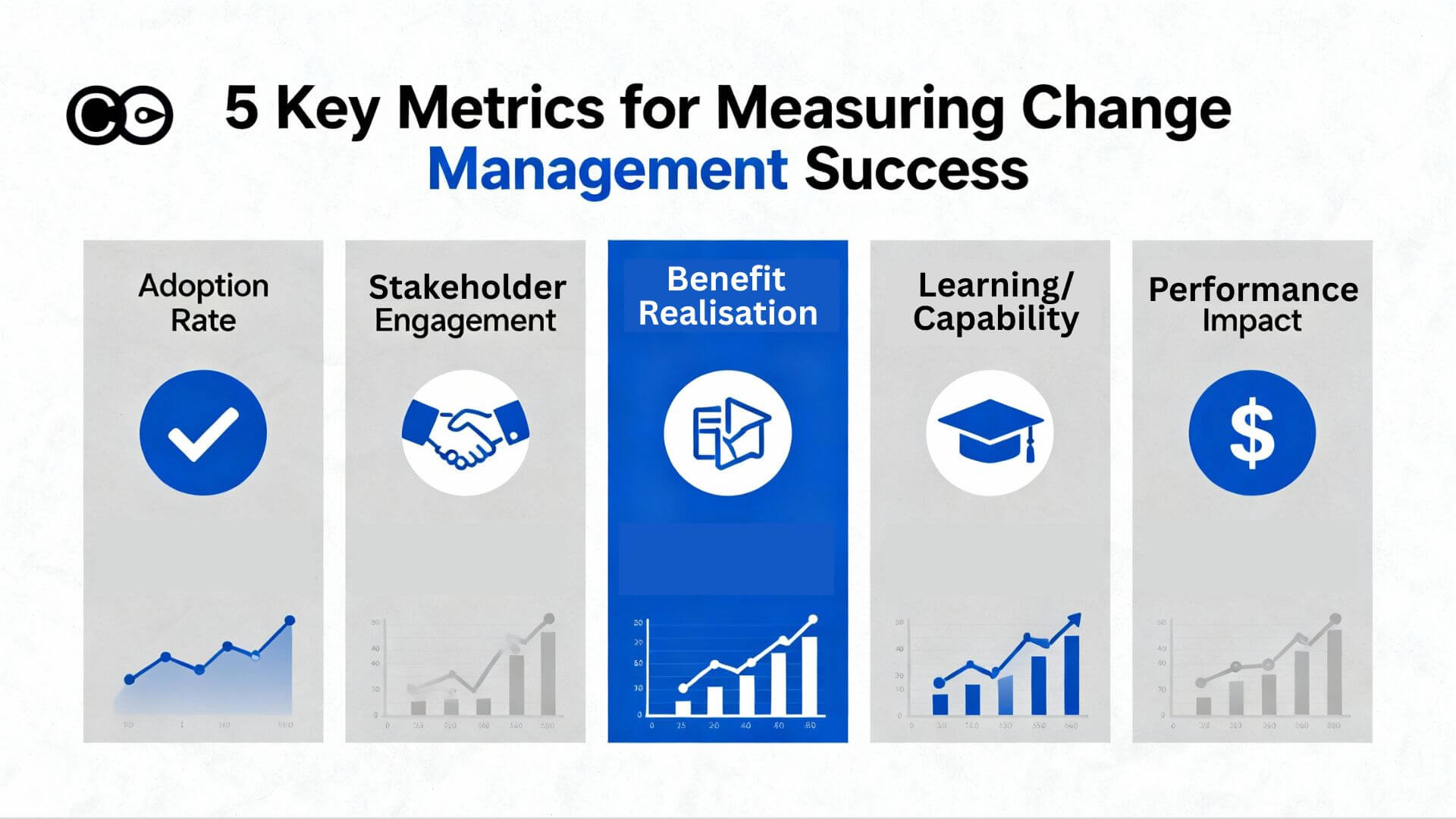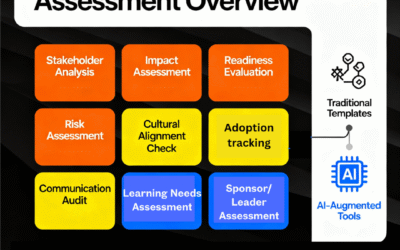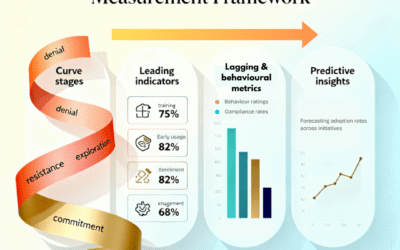The difference between organisations that consistently deliver transformation value and those that struggle isn’t luck – measurement. Research from Prosci’s Best Practices in Change Management study reveals a stark reality: 88% of projects with excellent change management met or exceeded their objectives, compared to just 13% with poor change management. That’s not a marginal difference. That’s a seven-fold increase in likelihood of success.
Yet despite this compelling evidence, many change practitioners still struggle to articulate the value of their work in language that resonates with executives. The solution lies not in more sophisticated frameworks, but in focusing on the metrics that genuinely matter – the ones that connect change management activities to business outcomes and demonstrate tangible return on investment.
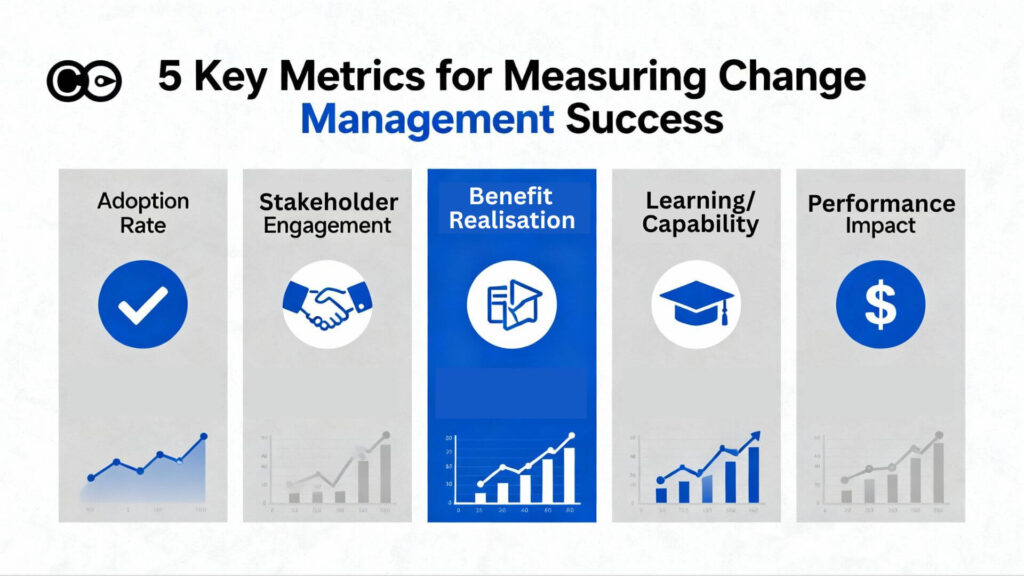
The five key metrics that matter for measuring change management success
Why Traditional Change Metrics Fall Short
Before exploring what to measure, it’s worth understanding why many organisations fail at change measurement. The problem often isn’t a lack of data – it’s measuring the wrong things. Too many change programmes track what’s easy to count rather than what actually matters.
Training attendance rates, for instance, tell you nothing about whether learning translated into behaviour change. Email open rates reveal reach but not resonance. Even employee satisfaction scores can mislead if they’re not connected to actual adoption of new ways of working. These vanity metrics create an illusion of progress whilst the initiative quietly stalls beneath the surface.
McKinsey research demonstrates that organisations tracking meaningful KPIs during change implementation achieve a 51% success rate, compared to just 13% for those that don’t – making change efforts four times more likely to succeed when measurement is embedded throughout. This isn’t about adding administrative burden. It’s about building feedback loops that enable real-time course correction and evidence-based decision-making.
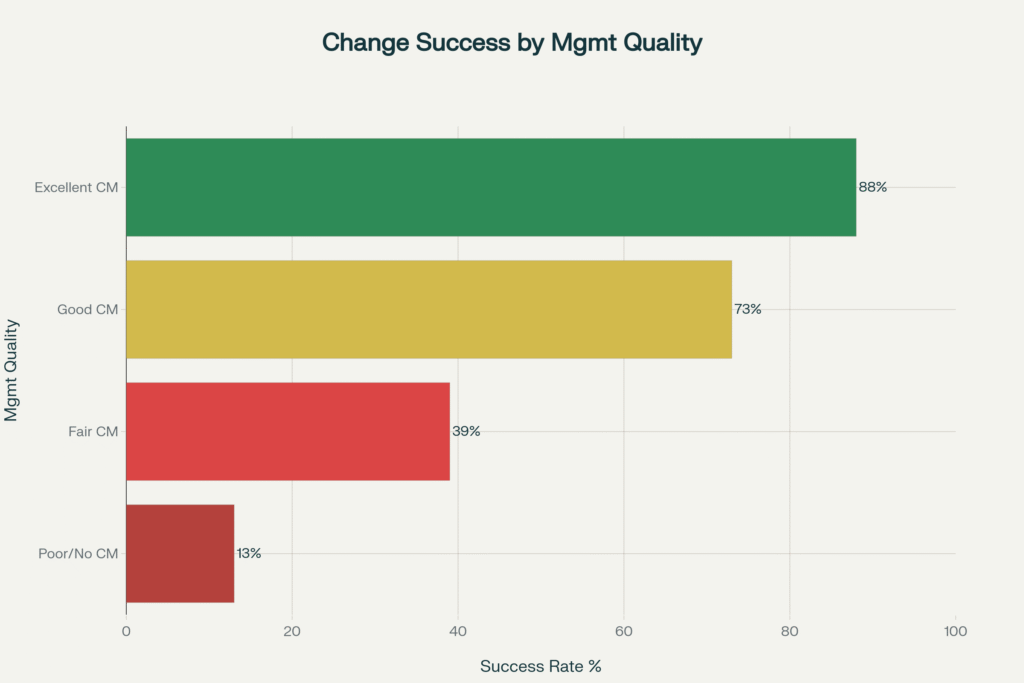
Research shows initiatives with excellent change management are 7x more likely to meet objectives than those with poor change management
The Three-Level Measurement Framework
A robust approach to measuring change management success operates across three interconnected levels, each answering a distinct question that matters to different stakeholders.
Organisational Performance addresses the ultimate question executives care about: Did the project deliver its intended business outcomes? This encompasses benefit realisation, ROI, strategic alignment, and impact on operational performance. It’s the level where change management earns its seat at the leadership table.
Individual Performance examines whether people actually adopted and are using the change. This is where the rubber meets the road – measuring speed of adoption, utilisation rates, proficiency levels, and sustained behaviour change. Without successful individual transitions, organisational benefits remain theoretical.
Change Management Performance evaluates how well the change process itself was executed. This includes activity completion rates, training effectiveness, communication reach, and stakeholder engagement. While important, this level should serve the other two rather than become an end in itself.
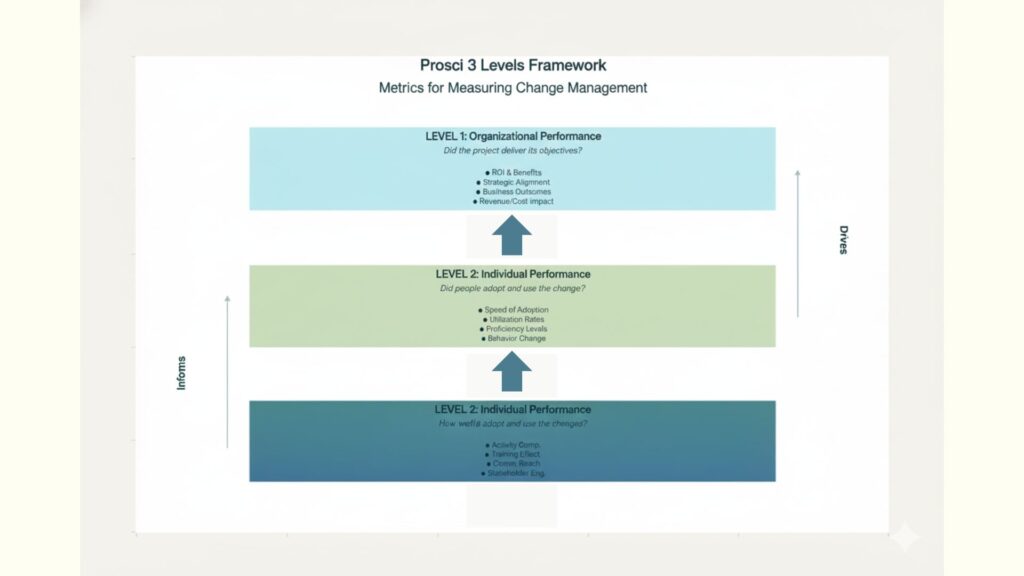
The Three-Level Measurement Framework provides a comprehensive view of change success across organizational, individual, and process dimensions
The power of this framework lies in its interconnection. Strong change management performance should drive improved individual adoption, which in turn delivers organisational outcomes. When you measure at all three levels, you can diagnose precisely where issues are occurring and take targeted action.
Metric 1: Adoption Rate and Utilisation
Adoption rate is perhaps the most fundamental measure of change success, yet it’s frequently underutilised or poorly defined. True adoption measurement goes beyond counting system logins or tracking training completions. It examines whether people are genuinely integrating new ways of working into their daily operations.
Effective adoption metrics include:
- Speed of adoption: How quickly did target groups reach defined levels of new process or tool usage? Organisations using continuous measurement achieve 25-35% higher adoption rates than those conducting single-point assessments.
- Ultimate utilisation: What percentage of the target workforce is actively using the new systems, processes, or behaviours? Technology implementations with structured change management show adoption rates around 95% compared to 35% without.
- Proficiency levels: Are people using the change correctly and effectively? This requires moving beyond binary “using/not using” to assess quality of adoption through competency assessments and performance metrics.
- Feature depth: Are people utilising the full functionality, or only basic features? Shallow adoption often signals training gaps or design issues that limit benefit realisation.
Practical application: Establish baseline usage patterns before launch, define clear adoption milestones with target percentages, and implement automated tracking where possible. Use the data not just for reporting but for identifying intervention opportunities – which teams need additional support, which features require better training, which resistance points need addressing.
Metric 2: Stakeholder Engagement and Readiness
Research from McKinsey reveals that organisations with robust feedback loops are 6.5 times more likely to experience effective change compared to those without. This staggering multiplier underscores why stakeholder engagement measurement is non-negotiable for change success.
Engagement metrics operate at both leading and lagging dimensions. Leading indicators predict future adoption success, while lagging indicators confirm actual outcomes. Effective measurement incorporates both.
Leading engagement indicators:
- Stakeholder participation rates: Track attendance and active involvement in change-related activities, town halls, workshops, and feedback sessions. In high-interest settings, 60-80% participation from key groups is considered strong.
- Readiness assessment scores: Regular pulse checks measuring awareness, desire, knowledge, ability, and reinforcement (the ADKAR dimensions) provide actionable intelligence on where to focus resources.
- Manager involvement levels: Measure frequency and quality of manager-led discussions about the change. Manager advocacy is one of the strongest predictors of team adoption.
- Feedback quality and sentiment: Monitor the nature of questions being asked, concerns raised, and suggestions submitted. Qualitative analysis often reveals issues before they appear in quantitative metrics.
Lagging engagement indicators:
- Resistance reduction: Track the frequency and severity of resistance signals over time. Organisations applying appropriate resistance management techniques increase adoption by 72% and decrease employee turnover by almost 10%.
- Repeat engagement: More than 50% repeat involvement in change activities signals genuine relationship building and sustained commitment.
- Net promoter scores for the change: Would employees recommend the new way of working to colleagues? This captures both satisfaction and advocacy.
Prosci research found that two-thirds of practitioners using the ADKAR model as a measurement framework rated it extremely effective, with one participant noting, “It makes it easier to move from measurement results to actions. If Knowledge and Ability are low, the issue is training – if Desire is low, training will not solve the problem”.
Metric 3: Productivity and Performance Impact
The business case for most change initiatives ultimately rests on productivity and performance improvements. Yet measuring these impacts requires careful attention to attribution and timing.
Direct performance metrics:
- Process efficiency gains: Cycle time reductions, error rate decreases, and throughput improvements provide concrete evidence of operational benefit. MIT research found organisations implementing continuous change with frequent measurement achieved a twenty-fold reduction in manufacturing cycle time whilst maintaining adaptive capacity.
- Quality improvements: Track defect rates, rework cycles, and customer satisfaction scores pre and post-implementation. These metrics connect change efforts directly to business outcomes leadership cares about.
- Productivity measures: Output per employee, time-to-completion for key tasks, and capacity utilisation rates demonstrate whether the change is delivering promised efficiency gains.
Indirect performance indicators:
- Employee engagement scores: Research demonstrates a strong correlation between change management effectiveness and employee engagement. Studies found that effective change management is a precursor to both employee engagement and productivity, with employee engagement mediating the relationship between change and performance outcomes.
- Absenteeism and turnover rates: Change fatigue manifests in measurable workforce impacts. Research shows 54% of change-fatigued employees actively look for new roles, compared to just 26% of those experiencing low fatigue.
- Help desk and support metrics: The volume and nature of support requests often reveal adoption challenges. Declining ticket volumes combined with increasing proficiency indicates successful embedding.
Critical consideration: change saturation. Research reveals that 78% of employees report feeling saturated by change, and 48% of those experiencing change fatigue report feeling more tired and stressed at work. Organisations must monitor workload and capacity indicators alongside performance metrics. The goal isn’t maximum change volume – it’s optimal change outcomes. Empirical studies demonstrate that when saturation thresholds are crossed, productivity experiences sharp declines as employees struggle to maintain focus across competing priorities.
Metric 4: Training Effectiveness and Competency Development
Training is often treated as a box-ticking exercise – sessions delivered, attendance recorded, job done. This approach fails to capture whether learning actually occurred, and more importantly, whether it translated into changed behaviour.
Comprehensive training effectiveness measurement:
- Pre and post-training assessments: Knowledge tests administered before and after training reveal actual learning gains. Studies show effective training programmes achieve 30% improvement in employees’ understanding of new systems and processes.
- Competency assessments: Move beyond knowledge testing to practical skill demonstration. “Show me” testing requires employees to demonstrate proficiency, not just recall information.
- Training satisfaction scores: While not sufficient alone, participant feedback on relevance, quality, and applicability provides important signals. Research indicates that 90% satisfaction rates correlate with effective programmes.
- Time-to-competency: How long does it take for new starters or newly transitioned employees to reach full productivity? Shortened competency curves indicate effective capability building.
Connecting training to behaviour change:
- Skill application rates: What percentage of trained behaviours are being applied 30, 60, and 90 days post-training? This measures transfer from learning to doing.
- Performance improvement: Are trained employees demonstrating measurably better performance in relevant areas? Connect training outcomes to operational metrics.
- Certification and accreditation completion: For changes requiring formal qualification, track completion rates and pass rates as indicators of workforce readiness.
The key insight is that training effectiveness should be measured in terms of behaviour change, not just learning. A change initiative might achieve 100% training attendance and high satisfaction scores whilst completely failing to shift on-the-ground behaviours. The metrics that matter connect training inputs to adoption outputs.
Metric 5: Return on Investment and Benefit Realisation
ROI measurement transforms change management from perceived cost centre to demonstrated value driver. Research from McKinsey shows organisations with effective change management achieve an average ROI of 143%, compared to just 35% for those without – a four-fold difference that demands attention from any commercially minded executive.
Calculating change management ROI:
The fundamental formula is straightforward:
Change Management ROI= (Benefits attributable to change management − Cost of change management ) / Cost of change management
However, the challenge lies in accurate benefit attribution. Not all project benefits result from change management activities – technology capabilities, process improvements, and market conditions all contribute. The key is establishing clear baselines and using control groups where possible to isolate change management’s specific contribution.
One aspect about change management ROI is that you need to think broader than just the cost of change management. You also need to take into account the value created (or value creation). To read more about this check out our article – Why using change management ROI calculations severely limits its value.
Benefit categories to track:
- Financial metrics: Cost savings, revenue increases, avoided costs, and productivity gains converted to monetary value. Be conservative in attributions – overstatement undermines credibility.
- Adoption-driven benefits: The percentage of project benefits realised correlates directly with adoption rates. Research indicates 80-100% of project benefits depend on people adopting new ways of working.
- Risk mitigation value: What costs were avoided through effective resistance management, reduced implementation delays, and lower failure rates? Studies show organisations rated as “change accelerators” experience 264% more revenue growth compared to companies with below-average change effectiveness.
Benefits realisation management:
Benefits don’t appear automatically at go-live. Active management throughout the project lifecycle ensures intended outcomes are actually achieved.
- Establish benefit baselines: Clearly document pre-change performance against each intended benefit.
- Define benefit owners: Assign accountability for each benefit to specific business leaders, not just the project team.
- Create benefit tracking mechanisms: Regular reporting against benefit targets with variance analysis and corrective actions.
- Extend measurement beyond project close: Research confirms that benefit tracking should continue post-implementation, as many benefits materialise gradually.
Reporting to leadership:
Frame ROI conversations in terms executives understand. Rather than presenting change management activities, present outcomes:
- “This initiative achieved 93% adoption within 60 days, enabling full benefit realisation three months ahead of schedule.”
- “Our change approach reduced resistance-related delays by 47%, delivering $X in avoided implementation costs.”
- “Continuous feedback loops identified critical process gaps early, preventing an estimated $Y in rework costs.”
Building Your Measurement Dashboard
Effective change measurement requires systematic infrastructure, not ad-hoc data collection. A well-designed dashboard provides real-time visibility into change progress and enables proactive intervention.
Dashboard design principles:
- Focus on the critical few: Resist the temptation to track everything. Identify 5-7 metrics that genuinely drive outcomes and warrant leadership attention.
- Balance leading and lagging indicators: Leading indicators enable early intervention; lagging indicators confirm actual results. You need both for effective change management.
- Align with business language: Present metrics in terms leadership understands. Translate change jargon into operational and financial language.
- Enable drill-down: High-level dashboards should allow investigation into specific teams, regions, or issues when needed.
- Establish regular cadence: Define clear reporting rhythms – weekly operational dashboards, monthly leadership reviews, quarterly strategic assessments.
Measurement best practices:
- Define metrics before implementation: Establish what will be measured and how before the change begins. This ensures appropriate baselines and consistent data collection.
- Use multiple measurement approaches: Combine quantitative metrics with qualitative assessments. Surveys, observations, and interviews provide context that numbers alone miss.
- Track both leading and lagging indicators: Monitor predictive measures alongside outcome measures. Leading indicators provide early warning; lagging indicators confirm results.
- Implement continuous monitoring: Regular checkpoints enable course corrections. Research shows continuous feedback approaches produce 30-40% improvements in adoption rates compared to annual or quarterly measurement cycles.
Leveraging Digital Change Tools
As organisations invest in digital platforms for managing change portfolios, measurement capabilities expand dramatically. Tools like The Change Compass enable practitioners to move beyond manual tracking to automated, continuous measurement at scale.
Digital platform capabilities:
- Automated data collection: System usage analytics, survey responses, and engagement metrics collected automatically, reducing administrative burden whilst improving data quality.
- Real-time dashboards: Live visibility into adoption rates, readiness scores, and engagement levels across the change portfolio.
- Predictive analytics: AI-powered insights that identify at-risk populations before issues escalate, enabling proactive rather than reactive intervention.
- Cross-initiative analysis: Understanding patterns across multiple changes reveals insights invisible at individual project level – including change saturation risks and resource optimisation opportunities.
- Stakeholder-specific reporting: Different audiences need different views. Digital tools enable tailored reporting for executives, project managers, and change practitioners.
The shift from manual measurement to integrated digital platforms represents the future of change management. When change becomes a measurable, data-driven discipline, practitioners can guide organisations through transformation with confidence and clarity.
Frequently Asked Questions
What are the most important metrics to track for change management success?
The five essential metrics are: adoption rate and utilisation (measuring actual behaviour change), stakeholder engagement and readiness (predicting future adoption), productivity and performance impact (demonstrating business value), training effectiveness and competency development (ensuring capability), and ROI and benefit realisation (quantifying financial return). Research shows organisations tracking these metrics achieve significantly higher success rates than those relying on activity-based measures alone.
How do I measure change adoption effectively?
Effective adoption measurement goes beyond simple usage counts to examine speed of adoption (how quickly target groups reach proficiency), ultimate utilisation (what percentage of the workforce is actively using new processes), proficiency levels (quality of adoption), and feature depth (are people using full functionality or just basic features). Implement automated tracking where possible and use baseline comparisons to demonstrate progress.
What is the ROI of change management?
Research indicates change management ROI typically ranges from 3:1 to 7:1, with organisations seeing $3-$7 return for every dollar invested. McKinsey research shows organisations with effective change management achieve average ROI of 143% compared to 35% without. The key is connecting change management activities to measurable outcomes like increased adoption rates, faster time-to-benefit, and reduced resistance-related costs.
How often should I measure change progress?
Continuous measurement significantly outperforms point-in-time assessments. Research shows organisations using continuous feedback achieve 30-40% improvements in adoption rates compared to those with quarterly or annual measurement cycles. Implement weekly operational tracking, monthly leadership reviews, and quarterly strategic assessments for comprehensive visibility.
What’s the difference between leading and lagging indicators in change management?
Leading indicators predict future outcomes – they include training completion rates, early usage patterns, stakeholder engagement levels, and feedback sentiment. Lagging indicators confirm actual results – sustained performance improvements, full workflow integration, business outcome achievement, and long-term behaviour retention. Effective measurement requires both: leading indicators enable early intervention whilst lagging indicators demonstrate real impact.
How do I demonstrate change management value to executives?
Frame conversations in business terms executives understand: benefit realisation, ROI, risk mitigation, and strategic outcomes. Present data showing correlation between change management investment and project success rates. Use concrete examples: “This initiative achieved 93% adoption, enabling $X in benefits three months ahead of schedule” rather than “We completed 100% of our change activities.” Connect change metrics directly to business results.
